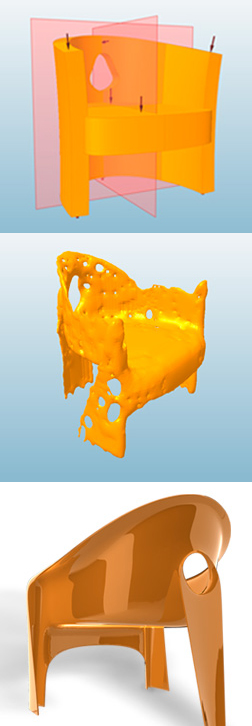July 30, 2012
Editors like to nitpick, not just about when to use semicolons and em dashes but also about the way specific terms are used in publications. The term that has lately been stirring up discussions and debates among DE editors is optimization. Last weekend, after visiting Altair‘s office in Troy, Michigan, I found myself deep in conversation with managing editor Jamie Gooch and executive editor Steve Robbins about the very topic. It’s important for us to have consensus because we’re considering a number of articles devoted to the subject in the year-end issue. The tone, the stories, and the perspectives of these stories will very likely be determined by how we define optimization.
Altair recently launched a site, dedicated to reducing weight in product design. In Altair’s own words, the Enlighten portal (a great pun to combine weight reduction and design wisdom) “strives to be the world’s leading source for useful, informative, and inspirational content concerned with minimizing the weight of products across industry.” The stories featured on the relatively young site include “Shedding Car Weight with Simulation Technology,” “Topology Optimization Joins the Mile High Club” (on refining aircraft nacelle hinge brackets), and “Aviation Industry Strengthened by Composites.”
Along with Altair, nearly all major CAD and simulation vendors are looking at optimization as the next big area to distinguish themselves from the rest. One way Altair accomplishes this is with its SolidThinking Inspire and Evolve software duo. Though digital simulation, inspire allows you to automatically identify the best (or optimal) shape for your design. Suppose you’re designing a gripper. Once you’ve defined the general region of your design (the block of geometry encompassing the gripper’s profile) and the anticipated loads and pressures, Inspire can run simulations in the background, then reveal the best possible shape for your gripper. Evolve can then help you build manufacturing-suitable parts and assemblies based on the optimal topology discovered. The use of direct modeling—the push-pull approach to geometry creation—makes the whole process much easier, especially for those untrained in traditional CAD programs.
Similarly, Autodesk Inventor’s Optimization module lets you find the best alternative by running a series of what-if scenarios. With Inventor, you have the option to run multiple simulation exercises in parallel (arguably the most compute-intensive portion of the task) in the cloud, on a remote server maintained by Autodesk and its partners. This approach avoids putting the burden on your personal workstation, which could become sluggish if it takes on multiple simulation jobs simultaneously.
Another major CAD and PLM vendor, Siemens PLM Software, offer its own product based on NX Nastran. SolidWorks, one of the most widely adopted MCAD package, offers a built-in optimization function (in Design Study tab) that lets you specify a variable range in your design (say, thickness within 0.5 to 1 inch), run multiple simulation sessions, then obtain the best value for your target criteria.
In nearly all the examples above, the approach is to use digital simulation to test out multiple design options (for example, a gripper with varying length in its claws or a bracket with varying thickness in its base), then let the software suggest the best possible option.
To explain its optimization approach, Siemens PLM Software notes, “Traditional ‘build-test-review-improve’ product cycles are typically performed using manual iterations. However, manual design sensitivity assessments are typically only based on changing one parameter at a time, to enable you to tell what causes the effects you see. NX Nastran Optimization streamlines and automates that process by using sophisticated algorithms to search the entire design space and find the right combination of parameters that will yield optimal design or performance.”
As engineers’ reliance on digital simulation grows, so does the number of iterations they must perform to find the best answer. Imagine identifying the optimal length for a camera’s built-in zoom lens. In a typical consumer model, when you turn on a point-and-shoot camera, the automatic lens can extend anywhere between 0.75 inch to 1.75 inch beyond its housing. The trick is to identify the right length—a value that lets you maintain the balanced feel in your hand, can be retracted completely into the flat housing when the job is done, can accommodate various shooting modes (closeup portraits, micro details, or distant landscapes), and can withstand an occasional drop with minimum injury. If you have to set up and run individual simulation sessions for each scenario, then review all the results to make a decision, it could be a daunting task. The preferred approach, as indicated by the design software makers’ method, is to run multiple simulations in the background and let the software suggest the best possible answer.
In the case of vehicles and airplanes, reducing weight is arguably the best optimization exercise: The lighter the product, the less fuel it needs to operate, and the less materials it requires to manufacture. But in some consumer goods, you may have to add weight to ensure durability and strength. If you’re designing parts that will eventually end up in a landfill, your optimization exercise may revolve around finding the best biodegradable material.
From overuse and hype, the term optimization, like its predecessor collaboration, could become an abstract term, a marketing slogan without substance. The optimal use of the term (if you’ll permit me a pun) is to always qualify it with a concrete objective: Optimizing the design for environmental health, for quick deployment in combat zone, for longevity, for recycling, for easy assembly, for child-proofing, for ease of use, and so on.
Subscribe to our FREE magazine, FREE email newsletters or both!
About the Author
Kenneth Wong is Digital Engineering’s resident blogger and senior editor. Email him at [email protected] or share your thoughts on this article at digitaleng.news/facebook.
Follow DE







